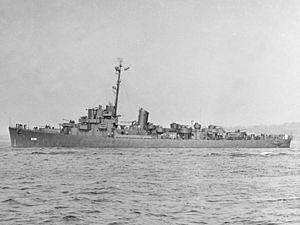USS Stewart (DE-238) facts for kids

USS Stewart in 1943
|
|
| History | |
|---|---|
| Name | Stewart |
| Namesake | Charles Stewart |
| Builder | Brown Shipbuilding, Houston, Texas |
| Laid down | 15 July 1942 |
| Launched | 22 November 1942 |
| Commissioned | 31 May 1943 |
| Decommissioned | January 1947 |
| Stricken | 1 October 1972 |
| Fate | Donated as a museum ship to Galveston, Texas on 25 June 1974 |
| General characteristics | |
| Class and type | Edsall-class destroyer escort |
| Displacement |
|
| Length | 306 ft (93.3 m) |
| Beam | 36.58 ft (11.1 m) |
| Draft | 10.42 ft (3.2 m) full load |
| Propulsion |
|
| Speed | 21 knots (39 km/h; 24 mph) |
| Range | 9,100 nmi (16,900 km; 10,500 mi) at 12 knots (22 km/h; 14 mph) |
| Complement | 8 officers, 201 enlisted |
| Armament |
|
|
USS Stewart
|
|
| Location | East End of Seawolf Park, Galveston, Texas |
| Area | 0.3 acres (0.12 ha) |
| NRHP reference No. | 07000689 |
| Added to NRHP | 12 July 2007 |
The USS Stewart (DE–238) is a special kind of ship called an destroyer escort. It was the third ship in the United States Navy to be named Stewart. This ship got its name from Rear Admiral Charles Stewart, a brave leader who commanded the famous USS Constitution during the War of 1812.
Today, the Stewart is one of only two destroyer escorts still preserved in the U.S. It is the only ship of its type, known as an Edsall-class vessel, that has been saved. You can visit it in Galveston, Texas, where it is a museum ship and open for everyone to explore.
Contents
Building the Ship
The Stewart (DE-238) was built in Houston, Texas. Its construction began on July 15, 1942. The ship was officially launched into the water on November 22, 1942. It was then ready to join the Navy on May 31, 1943.
After being built, the Stewart moved to Galveston for a short time. It then went to New Orleans, Louisiana, to get ready for its first missions. The ship practiced its skills near Bermuda for about a month. After that, it spent time in Miami, Florida, doing patrols and exercises.
World War II Adventures
During World War II, the Stewart had a very important job. It helped train new crews for other destroyer escort ships. It also protected groups of ships, called convoys, as they traveled across the ocean.
Protecting Convoys
In March 1944, the Stewart began escorting convoys across the Atlantic Ocean. These convoys carried important supplies and troops. The ship sailed to places like Iceland and Aruba. Its main task was to protect these convoys from enemy submarines.
The Stewart sometimes joined "hunter-killer" groups. These groups worked together to find and stop enemy submarines. In June 1944, it even practiced with a captured Italian submarine to improve its skills. The ship made several trips across the Atlantic, going to places like Naples, Italy, and England.
On one trip, the Stewart helped put out fires on a ship called SS Saint Mihiel. This happened after it collided with another ship. The Stewart played a vital role in keeping supply routes safe during the war.
Moving to the Pacific Ocean
By June 1945, the war in Europe was ending. The Stewart then moved to the Pacific Ocean. It sailed through the Panama Canal and arrived in San Diego, California. From there, it went to Pearl Harbor in Hawaii. The ship continued training exercises with other Navy vessels.
Life After the War
After World War II ended, the Stewart returned to the East Coast. In January 1947, it was placed into the reserve fleet. This means it was kept ready in case it was needed again, but it was not actively used. The ship stayed in reserve for many years, moving to different locations.
In 1972, the Navy decided the Stewart was no longer fit for service. Its name was removed from the official Navy list.
Becoming a Museum Ship
On June 25, 1974, the U.S. Navy gave the Stewart to the city of Galveston, Texas. It became part of the American Undersea Warfare Center at Seawolf Park. Another ship, the submarine Cavalla, was also donated.
Seawolf Park is a special place that remembers the USS Seawolf submarine and Texans who died in World War II. Both the Stewart and the Cavalla were placed on land at the park. In April 2024, the Stewart was repainted. It now looks like the USS Samuel B. Roberts did during World War II. This was done to remember the 80th anniversary of that ship's loss.
Challenges and Restoration
Over the years, the Stewart faced some tough times. It needed a lot of repairs because of weather damage and age. There was even a plan to scrap the ship at one point. However, people who cared about history fought to save it.
In 2008, Hurricane Ike hit Galveston. The storm caused a lot of damage to Seawolf Park and both the Stewart and Cavalla. But thanks to hard work and donations, both ships have been repaired. They are now maintained for visitors to enjoy.
A Historic Landmark
On November 11, 2007, the Stewart was added to the National Register of Historic Places. This means it is recognized as an important historical site in the United States. A special ceremony was held to celebrate this honor.
See also
- National Register of Historic Places listings in Galveston County, Texas
- Effects of Hurricane Ike in Texas
- USS Slater - another destroyer escort museum ship in Albany, NY.
Images for kids







